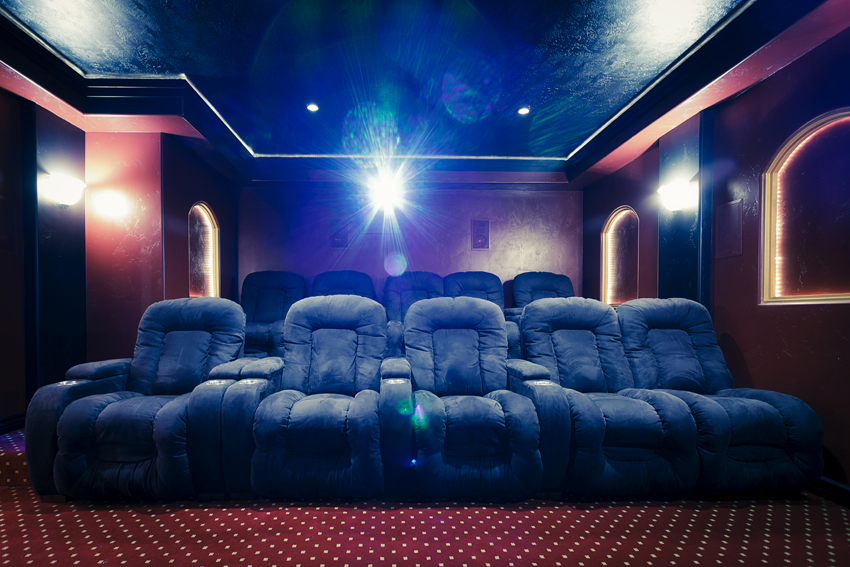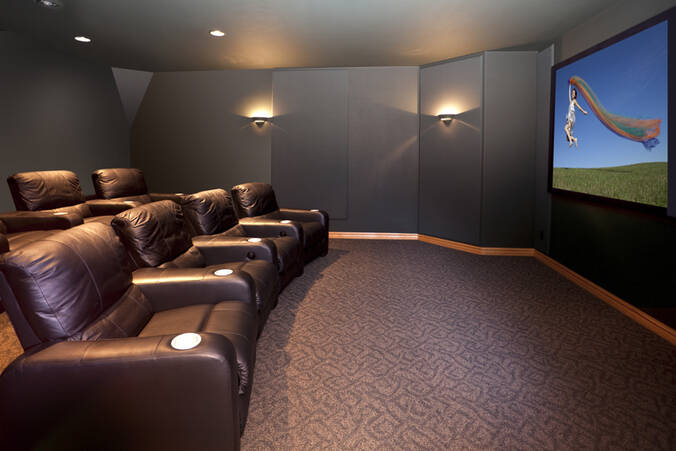Photographs: iStock
Do you yearn to kick back your heels and indulge in a good movie experience from the comfort of your home? Then a home theatre is just what the doctor's ordered for you. Here are tips by architect Aman Gandhi to design your very own movie-watching space economically, yet with great sound and picture quality.
1. Room: The best output of sound quality depends upon the room dimensions. The space that's slated to be your personal theatre should have a width approximately 1.5 times more than the height, and the length around 2.5 times the height.
2. Wall lights: Bright lights create a bad viewing experience. Ideally, dimmable LED fixtures of around 1-3 Watts should be used. While both ceiling-mounted and wall-mounted fixtures can fulfill this purpose, the former should always be concealed. The preferred lighting for a home theatre is indirect lighting.
3. Windows: As far as possible, avoid windows opening into the room selected for being turned into a home theatre. This is to avoid sound loss/leakage and filtration of external sound into the room. If a window is unavoidable, use good sound-proof glass for sound insulation.
4. Seating arrangement: The seating arrangement should be a stepped (auditorium-style) one as seen in cinema halls to provide a clear line of sight for people seated at the rear. The steps can be made in the floor itself: a level difference of around 6 in to 8 in between steps is more than adequate. Recliner sofas are popularly used for seating in home theatres to give proper comfort to the viewer.
 The seating arrangement should be a stepped (auditorium-style) one as seen in cinema halls to provide a clear line of sight for people seated at the rear. When it comes to lighting, indirect lighting is the recommended option.
The seating arrangement should be a stepped (auditorium-style) one as seen in cinema halls to provide a clear line of sight for people seated at the rear. When it comes to lighting, indirect lighting is the recommended option.5. Projector: An HD projector is a must for good picture quality. The projector should be ceiling-mounted to provide hindrance-free viewing and the distance between the screen and projector should be 13 ft to 15 ft (at least) from the screen to generate a good image. This distance also depends upon the size of the room. The most important thing to be kept in mind is that the image shouldn't be pixellated.
6. Sound system: The most enjoyable part of any movie is the sound effect. The sound system should be compatible with various gadgets such as the laptop, mobile phone, pen drive, video games, PlayStation, set-top boxes, etc. Usually, the selection of a sound system depends upon the size of the room and the intensity and quality which the user desires. The products that are available in the market usually come in configurations of 3.1 channel or 5.1 channel, with the 'channel' defining the power and intensity of sound that will be generated.
7. Screen: The size of the screen depends upon the dimension and proportions of the room. Generally, it is white in colour. Earlier, only fixed screens were available in the market, but nowadays rolling screens (which roll right up to the ceiling with the help of a motor) can be also considered.
8. False ceiling: It has a significant impact on the aesthetics and sound insulation of a home theatre. The cavity between the existing RCC ceiling and the false ceiling acts as sound insulation. The false ceiling should be porous and perforated. Usually, a 24 in x 24 in grid ceiling is used for this purpose which is then painted as per the theme and colour selection. Dark colours (even black) are recommended for a better viewing experience.
9. Wall treatment: Like false ceilings, cavity walls, too, prevent sound loss. They also act as a good sound insulation for acoustical purpose. This helps retain the sound quality. Cavity walls are created by making a false wall in front of the existing brick wall and filling the pocket with sound insulating material such as thermocole.
10. Upholstery: Again, dark colours promote better viewing. Leatherite should be avoided and only fabric with minute holes – used such cotton or velvet – should be used. These fabrics can be used on the wall as part of foam panels – which also aid sound insulation. The carpet that you select, should fit the overall colour, theme and ambience.
11. Floor lights: These really come in handy should you need to leave the room in the middle of a movie. You can use LED strips on the floor, with different colours and mix and match combinations. Just make sure that the colours complement your room.


















